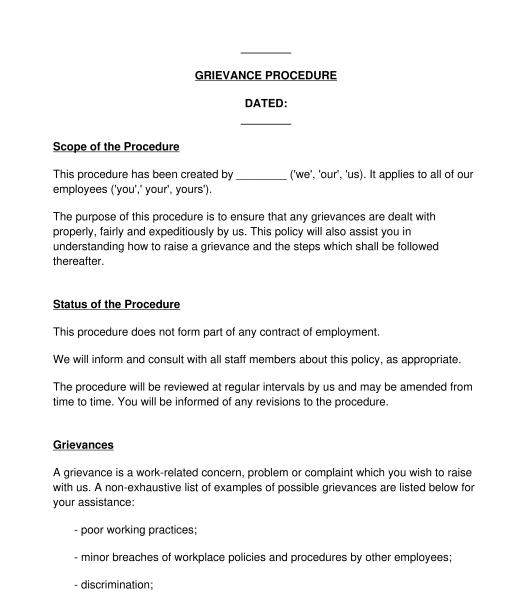 06/09/2025
06/09/2025

Answer a few questions and your document is created automatically.

Your document is ready! You will receive it in Word and PDF formats. You will be able to modify it.

 06/09/2025
06/09/2025
 Word and PDF
Word and PDF
 3 to 5 pages
3 to 5 pages
A grievance procedure can be used by an employer to explain how employees can raise a workplace complaint or a work-related issue. This grievance procedure can be used by an employer in Great Britain (England, Wales and Scotland).
A disciplinary procedure will explain the process for bringing disciplinary action against employees if they fail to follow workplace rules and requirements.
A grievance procedure will explain how employees can raise a grievance (complaint) about a work situation.
A complaints policy will address the process for external consumer complaints against the business. A consumer is an individual who purchases goods and/or services from a business for personal use.
A grievance procedure will be used internally by employees if they wish to raise a workplace issue or complaint to their employer.
Yes, an employer should hold a grievance procedure. An employer needs to specify in writing any grievance procedures that apply to employees. Where this information is not set out within a contract of employment, the employer should refer the worker or employee to a separate document.
A grievance is a problem or complaint. In a workplace setting, this will be an issue or problem experienced by an employee.
If an employer formally recognises a trade union or staff association, they may wish to consult and agree on the terms of the procedure document with them. Where a collective agreement* is in place between the employer and the relevant union or association this may be a legal requirement to consult with them about the procedure document.
The grievance procedure will apply to employees only and not any volunteers or other service providers connected to the employer.
A collective agreement is a written contract that is negotiated between a union and an employer on behalf of its union members.
The grievance policy should be made easily available and communicated to all employees. It is common to display workplace policies in an easily accessible public area, or within a staff handbook. The procedure will be provided to new employees when they start work, usually with their contract of employment.
It is also useful for employers to hold other relevant policy documents which may be read in conjunction with and may refer to the grievance procedure. For example, this may include:
A grievance procedure can remain in place indefinitely. However, it is important to make sure that the policy is reviewed and updated, as appropriate. Should the policy be revised or altered, these revisions and alterations must be communicated to employees at the earliest opportunity.
A grievance procedure should:
The main legal provisions which are relevant to a grievance procedure are:
You fill out a form. The document is created before your eyes as you respond to the questions.
At the end, you receive it in Word and PDF formats. You can modify it and reuse it.
Guides to help you
Grievance Procedure - Sample, template - Word & PDF
Country: United Kingdom